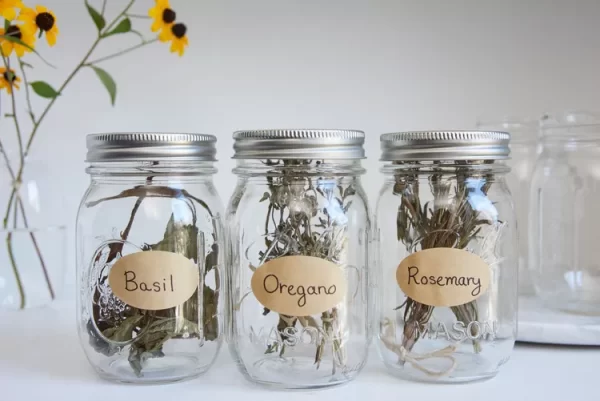The herbs from your garden are best when used fresh, but there are always more than you can use in one season. That’s where learning how to dry herbs comes in. Air drying is not only the easiest and least expensive way to dry fresh herbs, but this slow drying process can also help retain the essential oils of the herbs, which helps to maintain their flavor.

How to Dry Fresh Herbs
Gather Clippings
Gather the clippings you wish to dry.
Shake the Branches
Shake the branches gently to remove any insects. There are always hitchhikers, and since you won’t be thoroughly washing the stems, get rid of as many as you can right now.
Small pot with herbs held over wooden deck next to potted plants
Make Sure the Herbs Are Dry
If you’ve picked your herbs while the plants are dry, you should be able to simply shake off any excess soil. Rinse with cool water only if necessary and pat dry with paper towels. Hang or lay the herb branches out where they will get plenty of air circulation so they can dry out quickly. Wet herbs will mold and rot.
Remove the lower leaves along the bottom inch or so of the stem. You can use these leaves fresh or dry them separately. Remove any dry or diseased leaves from the cut herbs during this time. Yellowed leaves and leaves spotted by disease are not worth drying. Their flavor has already been diminished by the stress of the season.
Bundle four to six stems together and tie them as a bunch. You can either use a string or a rubber band. The bundles will shrink as they dry and the string will loosen, so check periodically to make sure that the bundle is not slipping. If you are trying to dry herbs that have high water content, make small bundles so they get air flowing between the branches and do not rot.
Add the Herbs to Paper Bags (Optional)
Though this step isn’t completely necessary, some find that paper bags aid in drying out the herbs more quickly and thoroughly. Punch or cut holes in a paper bag, and place the bundled herbs inside, upside down. Secure the bag by gathering the end around the bundle and tying it closed. Make sure the herbs are not crowded inside the bag. Label the bag with the name of the herb you are drying.
Hang the Herbs Upside Down
The oldest way to dry herbs is to take a bunch, hang it upside down in a warm, airy room and let nature do the work.
Hanging herbs upside down to dry

How to Store Herbs
Once you’ve completed the drying process:
Discard Any Moldy Herbs
Removing moldy leaves from a mint sprig
Store your dried herbs in airtight containers. Small canning jars work nicely. Zippered plastic bags will work, as well. Your herbs will retain more flavor if you store the leaves whole and crush them when you are ready to use them.
Adding dried herbs to zippered plastic bags
Label and date your containers.
Place containers in a cool, dry place away from direct sunlight. You can choose amber-colored canning jars that are designed to block sunlight.
Tips for Using Dried Herbs
You can begin using your herbs once the drying and storage process is complete:
When you want to use your herbs in cooking, simply pull out a stem and crumble the leaves into the pot. You should be able to loosen the leaves by running your hand down the stem.
Use about 1 teaspoon of crumbled dried leaves in place of 1 tablespoon of fresh herbs.
Dried herbs are best used within a year. As your herbs lose their color, they are also losing their flavor.
